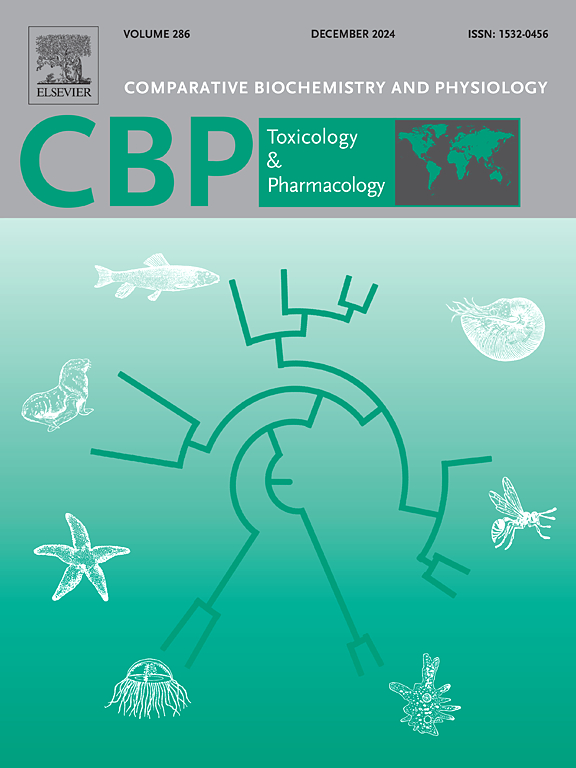Influence mechanism of sludge composting on antibiotic resistance genes under antibiotic stress: A comprehensive analysis
IF 4.3
3区 环境科学与生态学
Q2 BIOCHEMISTRY & MOLECULAR BIOLOGY
Comparative Biochemistry and Physiology C-toxicology & Pharmacology
Pub Date : 2025-07-22
DOI:10.1016/j.cbpc.2025.110297
引用次数: 0
Abstract
Antibiotic resistance genes (ARGs) are increasingly recognized as emerging contaminants that enter agricultural lands and surrounding ecosystems through the application of sewage sludge containing residual antibiotics. Composting is an effective method for reducing antibiotics and ARGs in sludge; however, the impact of residual antibiotics on the efficiency of ARG removal remains unclear. This study explored the reduction of oxytetracycline (OTC), sulfamerazine (SM1), and ciprofloxacin (CIP), as well as their impact on the removal of ARGs during sewage sludge composting. Our results demonstrated that composting achieved average removal efficiencies of 89.37 %, 72.63 %, and 82.98 % for OTC, CIP, and SM1, respectively. Metagenomic sequencing revealed that antibiotic residues significantly promoted the elimination of ARGs by 26.05–40.81 %. In contrast, the CK treatment resulted in a notable increase in tetracycline-resistant genes, particularly adeF, tetX, and soxR, compared to the levels reduced under antibiotic-induced selective pressure. Redundancy analysis (RDA) indicated that temperature, pH, C/N, CIP, and Proteobacteria, Tenericutes, and Chloroflexi were significant factors influencing the reduction of ARGs (P < 0.05). Network analysis further confirmed that Proteobacteria, particularly genera such as Pseudomonas and Pseudoxanthomonas, were predominantly associated with ARGs. These findings indicated that antibiotic residues can effectively promote the rebound of related ARGs, and offer valuable insights for the source control of ARGs.

抗生素胁迫下污泥堆肥对抗生素抗性基因影响机制的综合分析
抗生素耐药基因(ARGs)越来越被认为是一种新兴污染物,通过使用含有残留抗生素的污水污泥进入农田和周围生态系统。堆肥是减少污泥中抗生素和ARGs的有效方法;然而,残留抗生素对ARG去除效率的影响尚不清楚。本研究探讨了土霉素(OTC)、磺胺嗪(SM1)和环丙沙星(CIP)在污泥堆肥过程中的还原作用及其对ARGs去除的影响。结果表明,堆肥对OTC、CIP和SM1的平均去除效率分别为89.37%、72.63%和82.98%。宏基因组测序结果显示,抗生素残留显著促进ARGs的消除26.05 - 40.81%。相比之下,CK处理导致四环素耐药基因显著增加,尤其是adeF、tetX和soxR,而抗生素诱导的选择压力则降低了这些基因的水平。冗余分析(RDA)表明,温度、pH、C/N、CIP、Proteobacteria、Tenericutes和Chloroflexi是影响ARGs还原的重要因素(P <;0.05)。网络分析进一步证实变形菌属,特别是假单胞菌属和假黄单胞菌属,主要与ARGs相关。这些结果表明,抗生素残留可有效促进相关ARGs的反弹,为ARGs的源头控制提供了有价值的见解。
本文章由计算机程序翻译,如有差异,请以英文原文为准。
求助全文
约1分钟内获得全文
求助全文
来源期刊
CiteScore
7.50
自引率
5.10%
发文量
206
审稿时长
30 days
期刊介绍:
Part C: Toxicology and Pharmacology. This journal is concerned with chemical and drug action at different levels of organization, biotransformation of xenobiotics, mechanisms of toxicity, including reactive oxygen species and carcinogenesis, endocrine disruptors, natural products chemistry, and signal transduction with a molecular approach to these fields.

 求助内容:
求助内容: 应助结果提醒方式:
应助结果提醒方式:


